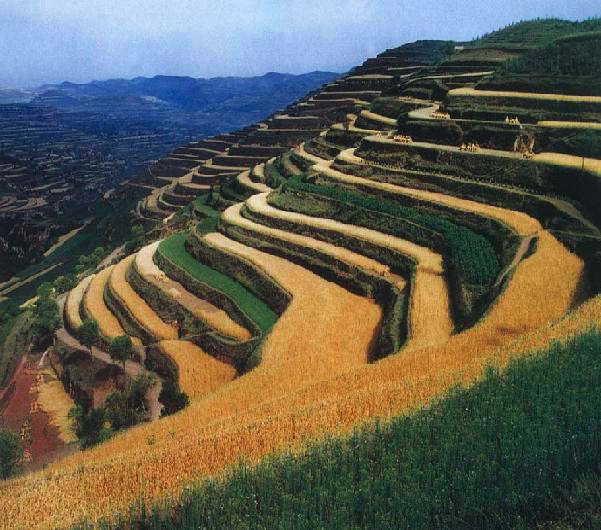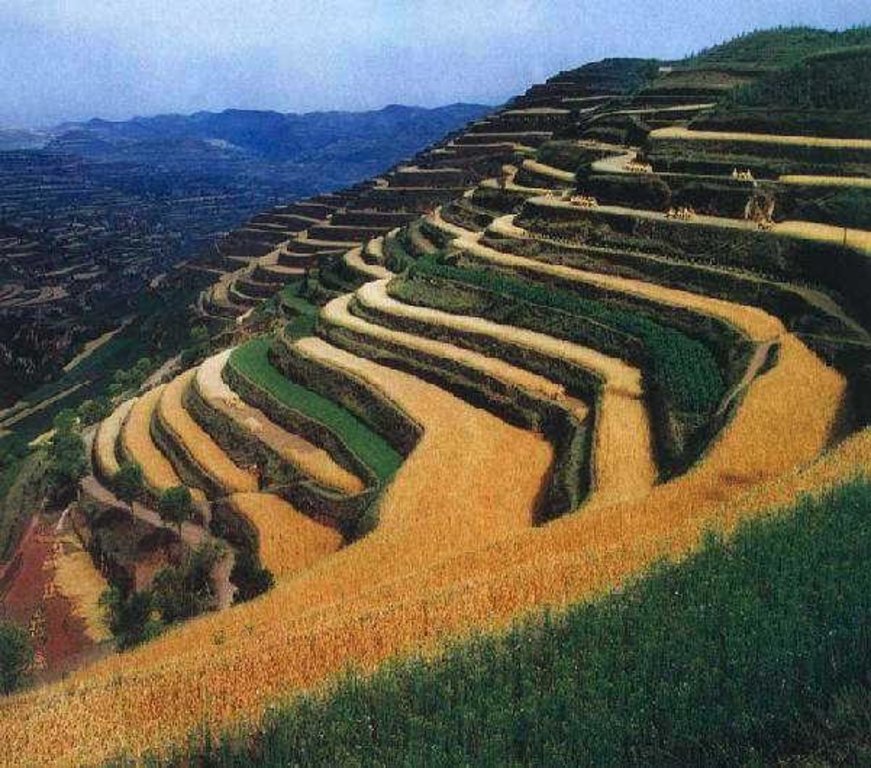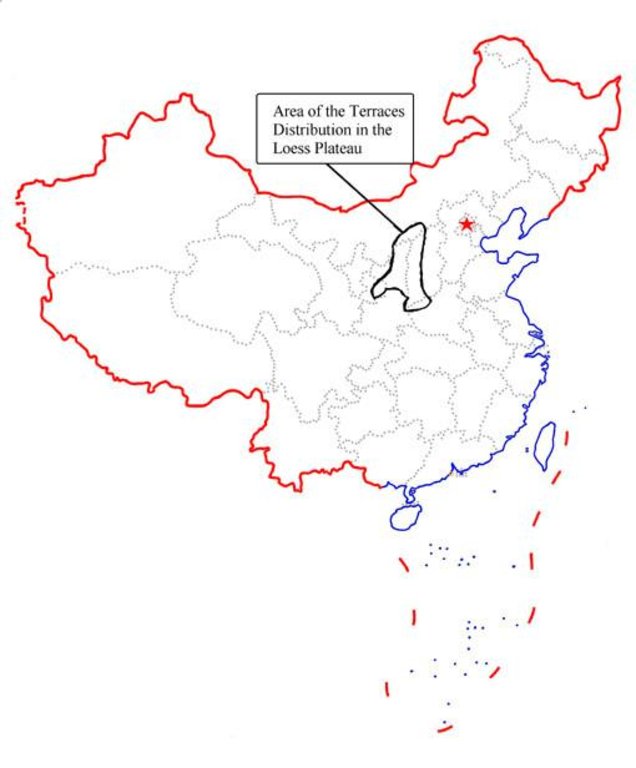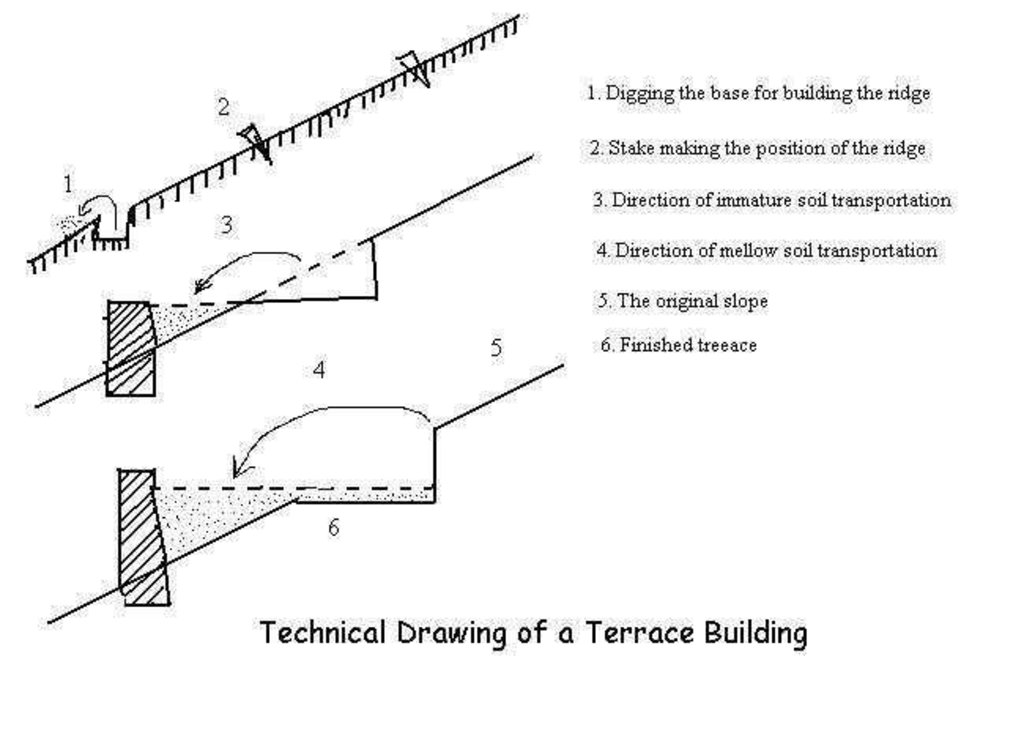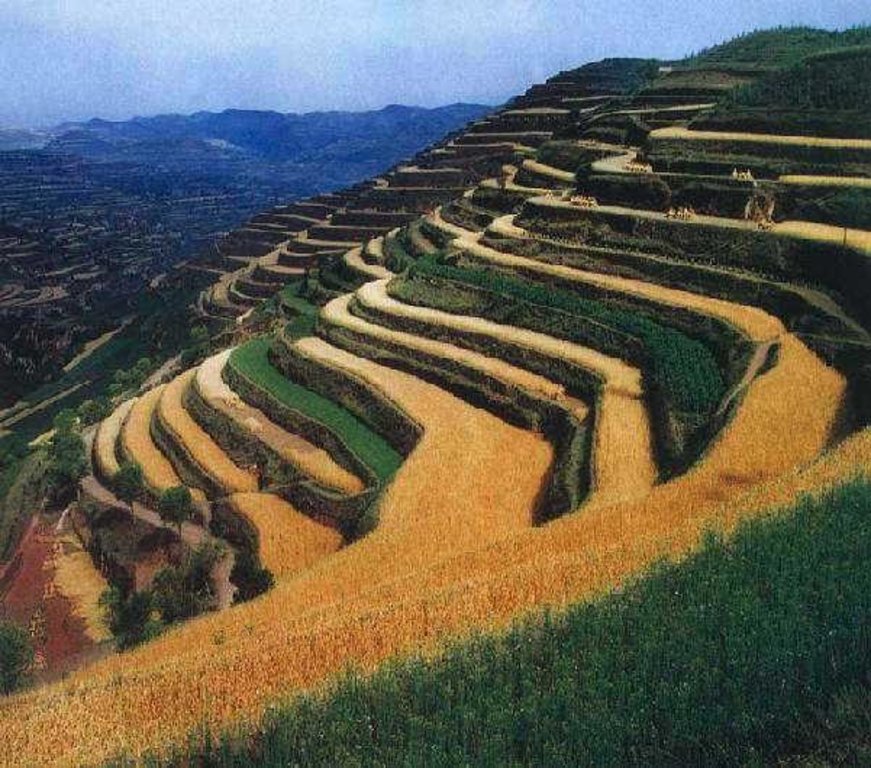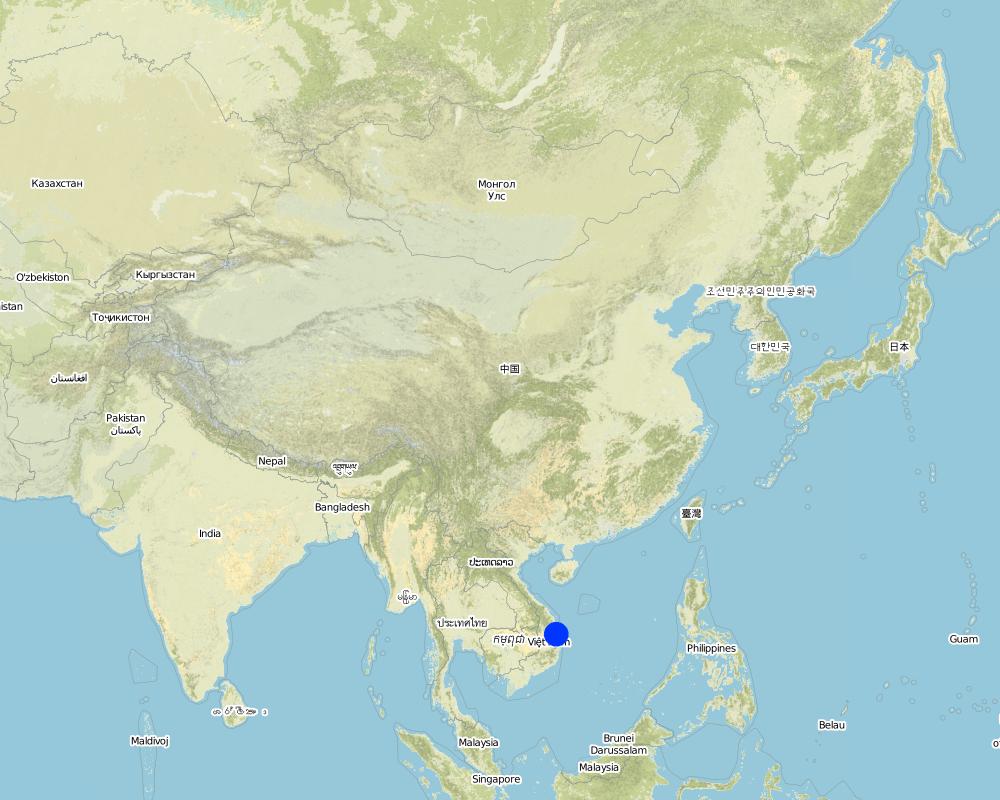Terrace [China]
- Creation:
- Update:
- Compiler: Meili WEN
- Editor: –
- Reviewer: David Streiff
approaches_2394 - China
View sections
Expand all Collapse all1. General information
1.2 Contact details of resource persons and institutions involved in the assessment and documentation of the Approach
SLM specialist:
1.3 Conditions regarding the use of data documented through WOCAT
The compiler and key resource person(s) accept the conditions regarding the use of data documented through WOCAT:
Yes
2. Description of the SLM Approach
2.1 Short description of the Approach
Terraces are built on a slope land which as a raised bank made up of earth or stone with vertical or sloping sides and an approximately flat top to control soil erosion and preserve and enhance soil fertility.
2.2 Detailed description of the Approach
Detailed description of the Approach:
Aims / objectives: A terrace has a raised bank made up of earth or stone with vertical or sloping sides and a flat top. It can reduce slope angle and length, wrap runoff, increase infiltration and reduce soil loss. Crops can grow well because water increases in the soil. The ground cover is improved. Terraces can be constructed by manual labor or machine. Firstly, surveying the slope hills and determining width of terraces according to the slope angle and soil texture. Secondly, leveling up the slope and constructing the banks. Thirdly, maintaining. The terraces are implemented together by state, local A terrace has a raised bank of earth or stone with vertical or sloping sides and a approximately flat top. It can reduce slope angle and length, retain runoff, increase infiltration and reduce the soil loss. Crops can grow well because water increases in soils. Meanwhile, ground cover is improved. Terrace can be constructed by manual labor or machine. Firstly, determining the width of the field according to the slope angle and soil texture. Secondly, putting the topsoil aside. Thirdly, leveling up the slope and constructing banks. At last, putting the topsoil to the top of the flat surface.
2.3 Photos of the Approach
2.5 Country/ region/ locations where the Approach has been applied
Country:
China
Region/ State/ Province:
Shaanxi, Shanxi, Gansu, Henan, Inner Mongolia
Map
×2.6 Dates of initiation and termination of the Approach
Indicate year of initiation:
1950
2.7 Type of Approach
- traditional/ indigenous
2.8 Main aims/ objectives of the Approach
The Approach focused mainly on SLM with other activities (Increasing crop yield.)
The main objectives of the approach were conserving soil and water on slope land and enhancing soil fertility.
The SLM Approach addressed the following problems: Soil loss and land degradation, lack of fund and technology.
2.9 Conditions enabling or hindering implementation of the Technology/ Technologies applied under the Approach
availability/ access to financial resources and services
- hindering
No enough money
Treatment through the SLM Approach: The national government partly fund, individual partly invests, local government partly invests.
legal framework (land tenure, land and water use rights)
- hindering
The existing land ownership, land use rights / water rights hindered a little the approach implementation The ownership of the land resources belongs to state and communities, land users can only lease the land for a period of time, they worry about their land would be transferred to others.
knowledge about SLM, access to technical support
- hindering
Poor knowledge for how to reduce the soil loss
Treatment through the SLM Approach: Ehancing SWC specialists guidance
other
- hindering
Peasant worry about that they can not own the use right.
Treatment through the SLM Approach: The national government advocates whose who invest labors who get the benefits.
3. Participation and roles of stakeholders involved
3.1 Stakeholders involved in the Approach and their roles
- local land users/ local communities
Working land users were mainly men (Men are the main force for field work.)
Existing groups of land users
Experienced peasant may be involved in introducing the local situations.
Men know much more technical knowledge and skills than women.
If a terrace is constructed by machine, men and women are not different. If a terrace is constructed by manual labor, men can do more work.
- SLM specialists/ agricultural advisers
- national government (planners, decision-makers)
3.2 Involvement of local land users/ local communities in the different phases of the Approach
| Involvement of local land users/ local communities | Specify who was involved and describe activities | |
|---|---|---|
| initiation/ motivation | none | rapid/participatory rural appraisal; The approach is a traditional way to harvest water and wrap soils, SWC applied land users easy to understand and accept it if some subsidy being obtained. |
| planning | passive | interviews/questionnaires; Being involved in the planning. |
| implementation | self-mobilization | responsibility for minor steps; Being involved in the planning. |
| monitoring/ evaluation | passive | reporting; No participating. |
| Research | none |
3.4 Decision-making on the selection of SLM Technology/ Technologies
Specify who decided on the selection of the Technology/ Technologies to be implemented:
- mainly SLM specialists, following consultation with land users
Explain:
consultative.
Decisions on the method of implementing the SLM Technology were made by by politicians / leaders. Generally, land users request. A proposal is prepared by SWC specialists or local government and submitted to leaders for being examined and approved.
4. Technical support, capacity building, and knowledge management
4.1 Capacity building/ training
Was training provided to land users/ other stakeholders?
Yes
Specify who was trained:
- land users
- extensionists/trainers, politicians/decision makers
Form of training:
- farmer-to-farmer
- demonstration areas
- courses
Subjects covered:
Teaching them how to design and build terraces on a slope land etc.
4.2 Advisory service
Do land users have access to an advisory service?
Yes
Specify whether advisory service is provided:
- on land users' fields
Describe/ comments:
Local government and SWC division.; Key elements: Demonstration, Visiting, Visiting; 1) Advisory service was carried out through: government's existing extension system 2) Advisory service was carried out through: government's existing extension system; Extension staff: mainly government employees 3) Target groups for extension: land users; Activities: Explain and demonstrate
Advisory service is quite adequate to ensure the continuation of land conservation activities; At each government level, there is a SWC division which is in charge of SWC activities including extension.
4.3 Institution strengthening (organizational development)
Have institutions been established or strengthened through the Approach?
- yes, moderately
Specify the level(s) at which institutions have been strengthened or established:
- local
Specify type of support:
- financial
4.4 Monitoring and evaluation
Is monitoring and evaluation part of the Approach?
Yes
Comments:
bio-physical aspects were regular monitored by 0 through measurements; indicators: None
technical aspects were regular monitored by 0 through measurements; indicators: None
socio-cultural aspects were ad hoc monitored by 0 through observations; indicators: None
economic / production aspects were regular monitored by 0 through measurements; indicators: None
area treated aspects were regular monitored by 0 through measurements; indicators: None
no. of land users involved aspects were ad hoc monitored by 0 through measurements; indicators: None
management of Approach aspects were ad hoc monitored by 0 through observations; indicators: None
There were few changes in the Approach as a result of monitoring and evaluation: None
4.5 Research
Was research part of the Approach?
Yes
Specify topics:
- economics / marketing
- ecology
- technology
Give further details and indicate who did the research:
Research was carried out both on station and on-farm
5. Financing and external material support
5.1 Annual budget for the SLM component of the Approach
Comments (e.g. main sources of funding/ major donors):
Approach costs were met by the following donors: government (national - fund): 100.0%
5.2 Financial/ material support provided to land users
Did land users receive financial/ material support for implementing the Technology/ Technologies?
Yes
5.3 Subsidies for specific inputs (including labour)
- equipment
| Specify which inputs were subsidised | To which extent | Specify subsidies |
|---|---|---|
| machinery | fully financed | |
| tools | fully financed | hand tools |
- agricultural
| Specify which inputs were subsidised | To which extent | Specify subsidies |
|---|---|---|
| seeds | fully financed | |
| fertilizers | fully financed | |
| seedlings and biocides | fully financed | |
- infrastructure
| Specify which inputs were subsidised | To which extent | Specify subsidies |
|---|---|---|
| community infrastructure | fully financed | |
If labour by land users was a substantial input, was it:
- paid in cash
Comments:
do some work during the construction of the terrace
Labour was also rewarded with other material support
5.4 Credit
Was credit provided under the Approach for SLM activities?
Yes
Specify conditions (interest rate, payback, etc.):
Interest rate charged: 0.5%
Interest was lower than market rate.
6. Impact analysis and concluding statements
6.1 Impacts of the Approach
Did the Approach help land users to implement and maintain SLM Technologies?
- No
- Yes, little
- Yes, moderately
- Yes, greatly
Subsoiling and applying more manure and compost.
Did the Approach improve issues of land tenure/ user rights that hindered implementation of SLM Technologies?
- No
- Yes, little
- Yes, moderately
- Yes, greatly
Persuading them to accept The problem is likely to be overcome in the near future. The relationship between land ownership and use rights can be properly dealt with by government and managers.
Did other land users / projects adopt the Approach?
- No
- Yes, little
- Yes, moderately
- Yes, greatly
According to the local situation, pits and check dam etc. also adopted in the approach.
6.3 Sustainability of Approach activities
Can the land users sustain what has been implemented through the Approach (without external support)?
- no
If no or uncertain, specify and comment:
no enough money and knowledge
6.4 Strengths/ advantages of the Approach
| Strengths/ advantages/ opportunities in the land user’s view |
|---|
| increase in production |
| Easier to till |
| Strengths/ advantages/ opportunities in the compiler’s or other key resource person’s view |
|---|
| Reduction of the slope angle (How to sustain/ enhance this strength: Raising terrace bank.) |
| reduction of the slope length (How to sustain/ enhance this strength: Protecting terrace banks by planting trees or others.) |
| Harvest of the runoff and increase in infiltration (How to sustain/ enhance this strength: Protecting the banks) |
| increase in soil fertility and organic matter (How to sustain/ enhance this strength: Applying manure and fertilizer) |
| improvement of ground cover (How to sustain/ enhance this strength: no till with mulching.) |
6.5 Weaknesses/ disadvantages of the Approach and ways of overcoming them
| Weaknesses/ disadvantages/ risks in the land user’s view | How can they be overcome? |
|---|---|
| Cost much. |
| Weaknesses/ disadvantages/ risks in the compiler’s or other key resource person’s view | How can they be overcome? |
|---|---|
| Decrease in production in the first1-2 year(s) | Fertilizering plenty of manure. |
| The ridge of the terrace is possible to be destroyed by storms and rats | Repairing and maintaining in time. |
7. References and links
7.1 Methods/ sources of information
- interviews with land users
7.2 References to available publications
Title, author, year, ISBN:
Suide Water and Soil Conservation examination station of Yellow River Water Resources Committee
Available from where? Costs?
Corpus of Test Research of Water and Soil Conservation (the second volume), 1981 ,p130~185
Title, author, year, ISBN:
Water and Soil Conservation Department of Yellow River Water Resources Committee of Ministry of Water Resources and Electric Power.
Available from where? Costs?
Corpus of economic benefits of water and soil measures, 1987, p77~102, 510~514
Title, author, year, ISBN:
ongyinglin,Changpiguang ,Wangzhihua. Discussion on the several questions on increasing production of the terrace with two banks.
Available from where? Costs?
Soil and Water Conservation Science and Technology in Shanxi, 1990, No.1, p36~37.
Title, author, year, ISBN:
Jiangdingsheng. Discussion on section design of the terrace on the Loess Plateau.
Available from where? Costs?
ACTA CONSERVATIONIS SOLI ET AQUAE SINICA, 1987,Vol.1,No.2, p28~35
Title, author, year, ISBN:
Liangqichun, Changfushuang , Liming. A study on drawing up budgetary estimate quota of terraced field.
Available from where? Costs?
Bulletin of Soil and Water Conservation, 2001,Vol.21,No.5, p41~44
Title, author, year, ISBN:
Liumingquan, Zhangaiqin, Liyouhua. Pattern engineering of reconstruction the slope cropland.
Available from where? Costs?
Soil and Water Conservation Science and Technology in Shanxi, 1992,No.3, p18~21.
Title, author, year, ISBN:
Lixuelian,Qiaojiping. Synthetic technology of fertilizing and improving production on the new terrace.
Available from where? Costs?
Soil and Water Conservation Science and Technology in Shanxi, 1998,No.3,p13~14.
Title, author, year, ISBN:
Terraces in China.
Available from where? Costs?
Ministry of Water Resources of China.The press of Jilin science technology , 1989
Links and modules
Expand all Collapse allLinks
No links
Modules
No modules


